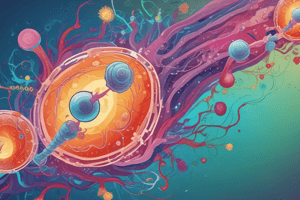Podcast
Questions and Answers
How do viruses replicate?
How do viruses replicate?
- By dividing independently like bacteria.
- Through direct invasion and destruction of host tissues.
- By releasing toxins that disrupt cellular functions.
- By utilizing host cell machinery to replicate their genetic material. (correct)
Which type of pathogen is characterized by being a eukaryotic organism that can be unicellular or multicellular and causes infections by invading tissues?
Which type of pathogen is characterized by being a eukaryotic organism that can be unicellular or multicellular and causes infections by invading tissues?
- Bacteria
- Fungi (correct)
- Viruses
- Parasites
What is the primary mechanism of defense provided by the innate immune system?
What is the primary mechanism of defense provided by the innate immune system?
- Activating memory cells for long-term immunity.
- Suppressing the immune response to prevent autoimmunity.
- Producing antibodies to target specific pathogens.
- Providing immediate, non-specific defense mechanisms. (correct)
How do helper T cells (CD4+) contribute to the adaptive immune response?
How do helper T cells (CD4+) contribute to the adaptive immune response?
Which of the following is NOT a mechanism by which antibodies protect against pathogens?
Which of the following is NOT a mechanism by which antibodies protect against pathogens?
What is the role of immunological memory in the adaptive immune response?
What is the role of immunological memory in the adaptive immune response?
How do mRNA vaccines work to protect against viral infections?
How do mRNA vaccines work to protect against viral infections?
What is the underlying cause of autoimmune disorders?
What is the underlying cause of autoimmune disorders?
Which mechanism is NOT a common way that bacteria develop antibiotic resistance?
Which mechanism is NOT a common way that bacteria develop antibiotic resistance?
What factors contribute to the emergence of infectious diseases?
What factors contribute to the emergence of infectious diseases?
Flashcards
Pathogens
Pathogens
Microorganisms that can cause disease, including viruses, bacteria, fungi, and parasites.
Pathogenicity
Pathogenicity
The ability of a pathogen to cause disease, influenced by virulence, transmission, and host susceptibility.
Airborne Transmission
Airborne Transmission
Spreading through the air via droplets or aerosols.
Direct Contact Transmission
Direct Contact Transmission
Signup and view all the flashcards
Waterborne Transmission
Waterborne Transmission
Signup and view all the flashcards
Vector-borne Transmission
Vector-borne Transmission
Signup and view all the flashcards
Immune System
Immune System
Signup and view all the flashcards
Innate Immune System
Innate Immune System
Signup and view all the flashcards
Adaptive Immune System
Adaptive Immune System
Signup and view all the flashcards
Antimicrobial Strategies
Antimicrobial Strategies
Signup and view all the flashcards
Study Notes
The provided text is identical to the existing notes. No new information is available to add so no changes have been made.
Studying That Suits You
Use AI to generate personalized quizzes and flashcards to suit your learning preferences.




